1. Identify me.
a. I am diploblastic & acoelomate. Which phylum do I belong to?
Answer:- I belong to phylum Scnidaria
b. My body is radially symmetrical. my body. I am referred as fish though I am not. What is my name?
Answer:- I belong to the phyllum Echinodermata and my name is Star fish/Asterias.
c. I live in your small intestine. Pseudocoelom is present in my thread like body. In which phylum will you include me?
Answer:_ You belong to the phyllum Aschelminthes and your name is Ascaris.
d. Though I am multicellular, there are no tissues in my body. What is the name of my phylum?
Answer:_ The name of phyllum is Porifera.
2. Write the characters of each of the following animals with the help of classification chart.
Bath sponge, grasshopper, rohu, penguin, frog, lizard, elephant, jellyfish.
Answer:_
3. Write in brief about progressive changes in animal classification
Answer:_ Greek philosopher Aristotle was one of the earliest known to perform animal classification, using the “Artificial method” which was based on characteristics such as body size, habits, and habitats. The “Artificial method” of classification was later followed by other philosophers and scientists like Theophrastus, Pliny, John Ray, and Linnaeus.
Later on, the “Natural system of classification” was adopted, which was based on various criteria like body organization, types of cells, chromosomes, bio-chemical properties, etc. This system of classification was further developed by scientists like Dobzhansky and Meyer, who emphasized the use of evolutionary relationships in classification.
Carl Woese also proposed a new system of animal classification, which was in practice until more recent times.
Currently, the five-kingdom classification system of Robert Whittaker is widely accepted, which includes all multicellular animals in the Kingdom Animalia. This system of classification is based on criteria such as body organization, body symmetry, body cavity, germinal layers, and segmentation.
4. What is the exact difference between grades of organization and symmetry? Explain with examples.
Answer:_Body organization is one of the criteria used in animal classification.
A. Body Organization
i. The body organization of unicellular animals is referred to as the “Protoplasmic grade” organization.
ii. In the case of multicellular animals, if tissues are not formed, their body organization is called the “Cellular grade” organization. Examples include Phylum Porifera.
iii. In the case of some animals, cells come together to form tissues, which perform all body functions. Such animals show “Cell-Tissue grade” organization. Examples include animals from Phylum Cnidaria.
iv. Flatworms show “Tissue-Organ grade” organization, in which tissues are organized to form organs, but complete organ systems are not formed.
v. The remaining animals show “Organ-System grade” organization, in which different organs are joined together to form organ systems that perform specific functions. Examples include the crab, frog, and human.
B. Body Symmetry
1 In an imaginary sense, if the body of any animal is cut through an imaginary axis of the body, it may or may not produce two equal halves. Depending on this property, there are different types of animal bodies.
2. Asymmetrical Body: In this type of body, there is no such imaginary axis of the body through which we can get two equal halves. Examples include Amoeba, Paramoecium, and some sponges.
3. Radial symmetry: In this type of body, if an imaginary cut passes through the central axis but any plane of the body, it gives two equal halves. Examples include the starfish.
4. Bilateral symmetry: In this type of body, there is only one such imaginary axis of the body through which we can get two equal halves. Examples include Insects, fishes, frog, birds, human, etc.
So, body organization and symmetry are two important criteria used in animal classification.
5. Answer in brief.
a. Give scientific classification of shark up to class.
Answer:- Kingdom- Animalia
Sub-kingdom- Chordates
Phylum- Chordata
Subphylum- Vertebrata
Class- Pisces
b. Write four distinguishing characters of phylum- Echinodermata.
Answer:_
Phylum- Echinodermata
1. Calcareous spines are present on the body of these animals; hence they are called as echinoderms.
2. These animals are found only in ocean.
3. Their body is triploblastic, eucoelomate. And it is radially symmetrical in adult stage. However, they show bilateral symmetry in larval stage.
4. They perform locomotion with the help of tube-feet. Tube feet are also useful for capturing the prey. Some animals are sedentary.
5. They have skeleton made up of calcareous spines and/or ossicles (plates).
6. These animals have good ability of regeneration. 7. These animals are mostly unisexual.
Examples: Star fish, sea-urchin, brittle star, sea-cucumber, etc.
c. Distinguish between butterfly and bat with the help of four distinguishing properties.
Answer:-
d. To which phylum does Cockroach belong? Justify your answer with scientific reasons.
Answer:-
1. Cockroach belongs to the phylum Arthropoda.
2. These animals have jointed appendages.
3. They are found in all types of habitats ranging from deepest oceans to highest mountains.
4. Body of these animals is triploblastic, eucoelomate, bilaterally symmetrical and segmented. 5. Chitinous exoskeleton is present around their body.
6. Give scientific reasons.
a. Though tortoise lives on land as well as in water, it cannot be included in class- Amphibia.
Answer:- Tortoise belongs to the class Reptilia, which includes animals that are characterized by having scaly skin, laying eggs with leathery shells, and being cold-blooded. This class includes many species of lizards, snakes, crocodiles, and turtles, including the tortoise. Unlike amphibians, which have moist, permeable skin and undergo a metamorphosis from a water-dwelling tadpole stage to a land-dwelling adult stage, reptiles have dry, scaly skin and do not undergo a metamorphosis.
b. Our body irritates if it comes in contact with jelly fish.
Answer:_ Jellyfish venom can cause a variety of symptoms if it comes into contact with human skin. These can include pain, itching, redness, and rash. In some cases, the venom can also cause more severe symptoms such as difficulty breathing, muscle cramps, and weakness. If you come into contact with a jellyfish, it is important to remove any tentacles that may be attached to your skin and rinse the affected area with seawater. If symptoms are severe or if you have a known allergy to jellyfish venom, seek medical attention immediately.
c. All vertebrates are chordates but all chordates are not vertebrates
Answer:- All vertebrates are chordates, but not all chordates are vertebrates.
Chordates are a diverse group of animals that share certain common characteristics, such as a notochord (a flexible rod that runs along the back of the animal), a hollow nerve cord, and pharyngeal slits (gill openings). Vertebrates are a subgroup of chordates that are characterized by the presence of a spinal column or backbone, which provides support and protection for the spinal cord.
Examples of chordates include fish, amphibians, reptiles, birds, and mammals (vertebrates) and also includes animals like tunicates and lancelets which are invertebrates.
d. Balanoglossus is connecting link between non-chordates & chordates.
Ans:- Balanoglossus is a genus of marine invertebrates that are considered to be “living fossils” because they share characteristics with both non-chordates and chordates. They are known to be a group of animals that are believed to be the closest relatives of the chordates and are sometimes referred to as “hemichordates.”
Balanoglossus is a worm-like organism that lives in marine environments and is considered a type of acorn worm. They possess some of the key characteristics of chordates, such as a notochord, a hollow nerve cord and pharyngeal slits, but lack others, such as a vertebral column.
Because of their unique characteristics, Balanoglossus is considered as an important organism in understanding the evolutionary history of the chordates.
e. Body temperature of reptiles is not constant.
Answer:- Reptiles are cold-blooded animals, also known as ectotherms, which means that their body temperature is not internally regulated and is dependent on the external environment. This is in contrast to warm-blooded animals, also known as endotherms, which can maintain a constant internal body temperature regardless of external conditions.
Reptiles rely on external sources of heat, such as the sun or warm surfaces, to raise their body temperature and increase their metabolism, which allows them to move and hunt more efficiently. When the temperature drops, reptiles will seek out cooler areas to lower their body temperature and slow down their metabolism. This is why reptiles are often seen basking in the sun or hiding in the shade.
The body temperature of reptiles can vary widely depending on the environment they are in, with temperatures ranging from well below freezing to over 40 degrees Celsius. This can affect their behavior, movement, digestion, and overall health.
7. Answer the following questions by choosing correct option.
a. Which special cells are present in the body of sponges (Porifera)?
1. Collar cells. 2. Cnidoblasts.
3. Germ cells. 4. Ectodermal cells.
b. Which of the following animals’ body shows bilateral symmetry?
1. Star fish. 2. Jelly fish.
3. Earthworm. 4. Sponge.
c. Which of the following animals can regenerate it’s broken body part?
1. Cockroach. 2. Frog.
3. Sparrow. 4. Star fish.
d. Bat is included in which class?
1. Amphibia. 2. Reptilia.
3. Aves. 4. Mammalia.
Answer:-
a. Which special cells are present in the body of sponges (Porifera)?
- Collar cells.
b. Which of the following animals’ body shows bilateral symmetry?
2. Jelly fish.
c. Which of the following animals can regenerate it’s broken body part?
4. Star fish.
d. Bat is included in which class?
4. Mammalia.
8. Complete the following chart.
| Body cavity | Germ Layer | Phylum |
|---|---|---|
| Absent | – | Porifera |
| Absent | Triploblastic | – |
| Pseudocoelom | – | Aschelminthes |
| Present | – | Arthropoda |
Answer:-
| Body cavity | Germ Layer | Phylum |
|---|---|---|
| Absent | single layer | Porifera |
| Absent | Triploblastic | Platyhelmenthes |
| Pseudocoelom | Triploblastic | Aschelminthes |
| Present | Triploblastic | Arthropoda |
9. Complete the following chart.
| Type | Character | Example |
|---|---|---|
| Cyclostomata | – | – |
| – | Gill Respiration | – |
| – | – | Whale |
| Poikilotherms | – | – |
Answer:
| Type | Character | Example |
| Cyclostomata | Jaw less mouth | Myxine |
| Pisces | Gill respiration | Rohu |
| Amphibia | Aquatic and aerial respiration | Frog |
| Mammalia | Mammary glands | Whale |
| Reptilia | Poikilotherms | Lizard |
10. Sketch, label and classify
Hydra, Jellyfish, Planaria, Round worm, Butterfly, Earthworm, Octopus, Star fish, Shark, Frog, Wall lizard, Pigeon
- Hydra

Kingdom- Animalia
Body organization- Cell tissue
Body symmetry- Radial symmetry
Body cavity- Acoelomate
Phylum- Cnidaria
2) Jelly Fish
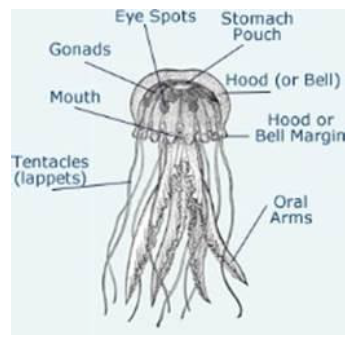
Body organization- Cell tissue
Body symmetry- Radial symmetry
Body cavity- Acoelomate
Phylum- Cnidaria
3) Planaria :-
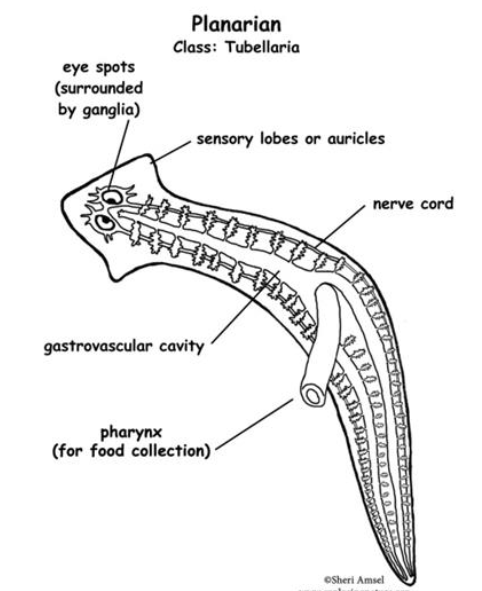
Kingdom- Animalia
Body organization- Tissue grade
Body symmetry- Bilateral symmetry
Body cavity- Acoelomate
Phylum- Platyhelminthes
4) Round worm
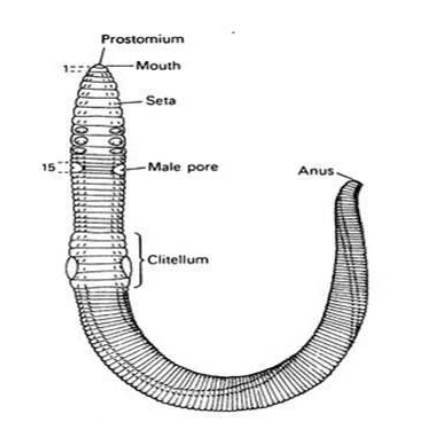
Kingdom- Animalia
Body organization- Organ system grade
Body symmetry- Bilateral symmetry
Body cavity- Eucoelomate
5) Butterfly

Phylum- Annelida
Kingdom- Animalia
Body organization- Organ system grade
Body symmetry- Bilateral symmetry
Body cavity- Eucoelomate
6) Earthworm
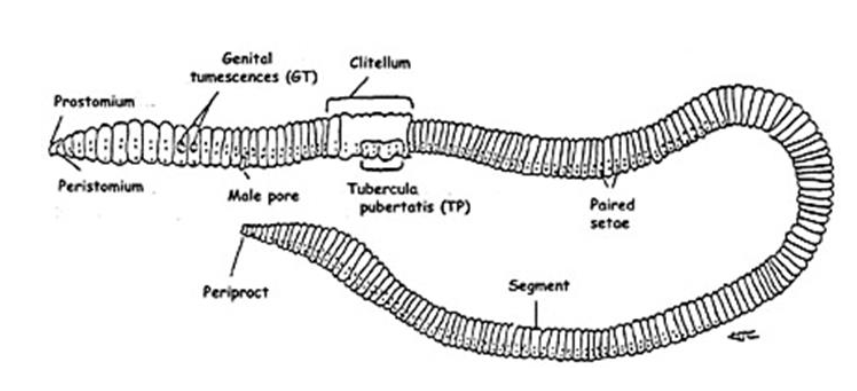
Phylum- Arthropoda
Kingdom- Animalia
Body organization- Organ system grade
Body symmetry- Bilateral symmetry
Body cavity- Eucoelomate
7) Octopus

Phylum- Annelida
Kingdom- Animalia
Body organization- Organ system grade
Body symmetry- Bilateral symmetry
Body cavity- Eucoelomate
8) Star Fish
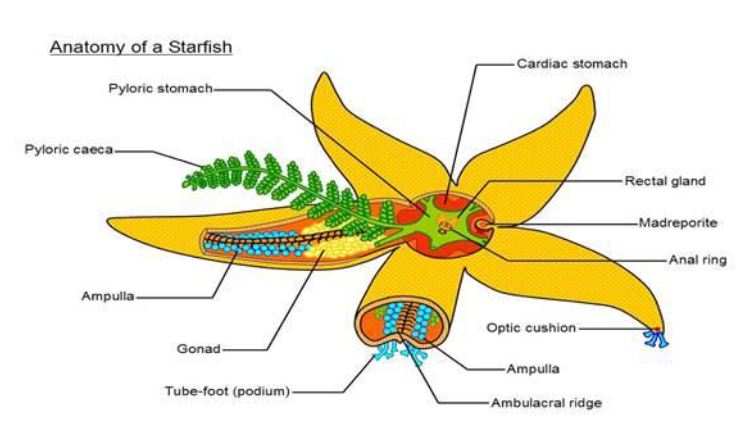
Phylum- Mollusca
Kingdom- Animalia
Body organization- Organ system grade
Body symmetry- Bilateral symmetry
Body cavity- Eucoelomate
Phylum- Echinodermata
9) Shark

Kingdom- Animalia
Body organization- Organ system grad
e Body symmetry- Bilateral symmetry
Body cavity- Eucoelomate
Phylum- Pisces
10) Frog

Kingdom- Animalia
Body organization- Organ system grade
Body symmetry- Bilateral symmetry
Body cavity- Eucoelomate
11) Wall Lizard
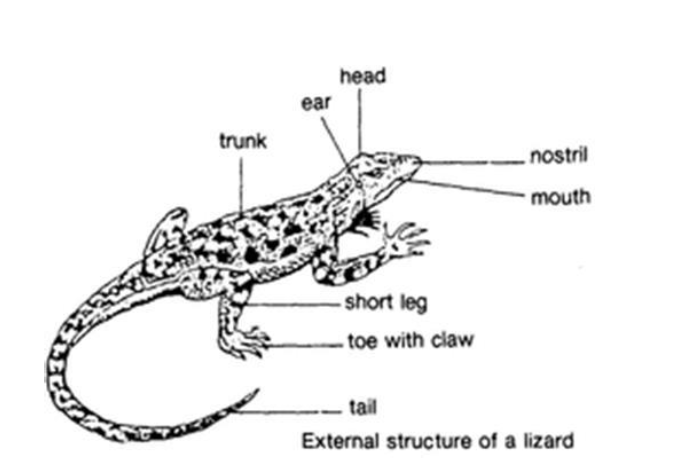
Phylum- Amphibia
Kingdom- Animalia
Body organization- Organ system grade
Body symmetry- Bilateral symmetry
Body cavity- Eucoelomate
13) Pegion
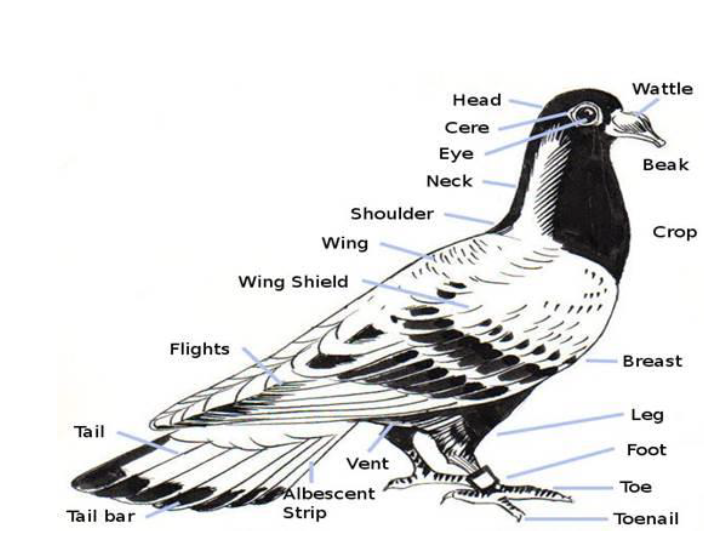
Phylum- Reptilia
Kingdom- Animalia
Body organization- Organ system grade
Body symmetry- Bilateral symmetry
Body cavity- Eucoelomate
Phylum- Aves
11. Label the following.

